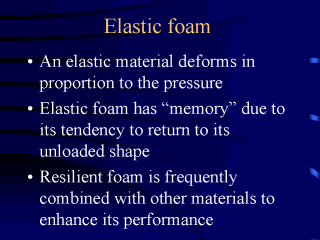 |
An elastic
material deforms in proportion to the applied load: greater loads result in predictably
greater deformations and vice versa. If time is a factor in the load versus deformation
characteristic, then the response is considered to be viscoelastic, which will be
discussed separately. The response of support surfaces made from resilient foam is
predominately elastic. Foam support surface products are made from two basic types of foam
- open cell or closed cell. Foam is said to have "memory" because of its
tendency to return to its nominal shape or thickness. Bryant suggests that the minimum
density or weight per cubic foot of the bed support surface material should be 1.3 to 1.6
pounds and convoluted foam should have a minimum of 4 inches from the bottom of the foam
to the lowest point of the convolution to achieve the optimal pressure reducing effects of
the material. Foam products frequently consist of foam layers of varying densities or
combinations of gel and foam. Other products have a series of air-filled chambers covered
with a foam structure or are available as multi-density closed cell products, 4-10 inches
deep with deflectable tips. For these types of products, "memory" is not total
because only the foam components will return to their unloaded shape. Several seat cushion
products have this construction. The advantage of support surfaces with a combination of
fluid-filled bladders and resilient foam would be to provide a degree of postural
stability with a resilient shell and improved envelopment with a fluid or viscous
fluid-filled layer at the interface. |
